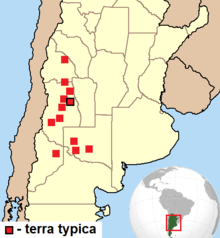Plains viscacha rat
| Plains viscacha rat | |
|---|---|
 | |
| Scientific classification | |
| Kingdom: | Animalia |
| Phylum: | Chordata |
| Class: | Mammalia |
| Order: | Rodentia |
| Family: | Octodontidae |
| Genus: | Tympanoctomys Yepes, 1942 |
| Species: | T. barrerae |
| Binomial name | |
| Tympanoctomys barrerae (B. Lawrence, 1941)[2] | |
 | |
The plains viscacha rat or red vizcacha rat (Tympanoctomys barrerae) is a species of rodent in the family Octodontidae native to Argentina. It is one of two species in the genus Tympanoctomys.[3][4]
Description
The plains viscacha rat is a moderately-sized rat, with a large head, long tail, and short ears. Adults measure about 13 cm (5.1 in) in total length, with a 15 cm (5.9 in) tail, and weigh an average of 90 g (3.2 oz), with males being slightly larger than females. The rat has buff-yellow fur with white underparts, fading to dark brown at the tip of the tail.[5]
Distribution and habitat
The plains viscacha rat is endemic to central western Argentina, where it has a fragmented range in Mendoza Province and western La Pampa. Its natural habitat is desert scrubland, dunes and salt flats, between 300 and 1,400 m (980 and 4,590 ft). There are no recognised subspecies.[1][5]
The species is threatened by destruction of its fragmented and restricted habitat.[1]
Biology and behaviour
Plains viscacha rats are solitary, and nocturnal. They construct complex burrow systems within large artificial mounds.[6] Typical mounds are 13.6 by 8.7 m (45 by 29 ft) across, and 1.25 m (4 ft 1 in) in height, and have an average of 23 burrow entrances. Within the mound, the burrow system has up to three levels and contains numerous chambers and dead-end tunnels.[5]
The rats are herbivorous, feeding primarily on halophytic vegetation, such as Atriplex and Suaeda,[7] although they will occasionally eat other plants such as grass.[5] The rats scrape salt from the leaves of Atriplex saltbushes with their teeth and bristles around their mouths before eating them.[8] Although this reduces their salt intake, they still produce highly concentrated urine to help maintain their water balance.[9]
The young are born blind, and weighing about 4 g (0.14 oz). Their eyes open at about six days, and they begin to take solid food at ten days.[5]
Genetics
.jpg)
This species of rodent was thought unusual because it was thought to be tetraploid (4x = 2n = 102). Scientists thought that this species may have arisen by hybridization and chromosome doubling from an ancestor (very possibly closely related to the mountain vizcacha rat, Octomys mimax, chromosome count 2x = 2n = 56). The doubling of its chromosome number was presumably by errors in mitosis or meiosis within the animal's reproductive organs.[10] The animal's spermatozoa are roughly twice normal size, thought to be by virtue of having twice as many sets of chromosomes.[11]
However, careful analysis using chromosome paints shows that there are only two copies of each chromosome in T. barrerae, not the four expected if it were truly a tetraploid.[12] The rodent is not a rat, but kin to guinea pigs and chinchillas. Its "new" diploid [2n] number is 102 and so its cells are roughly twice what would normally be expected.
References
- 1 2 3 Lessa, E.; Ojeda, R. & Bidau, C. (2008). "Tympanoctomys barrerae". IUCN Red List of Threatened Species. Version 2008. International Union for Conservation of Nature. Retrieved 5 January 2009.
- ↑ Lawrence, B. (1941), "A new species of Octomys from Argentina", Proceedings of the New England Zoological Club, 18: 43–46
- ↑ Woods, C.A.; Kilpatrick, C.W. (2005). "Infraorder Hystricognathi". In Wilson, D.E.; Reeder, D.M. Mammal Species of the World: A Taxonomic and Geographic Reference (3rd ed.). Johns Hopkins University Press. p. 1573. ISBN 978-0-8018-8221-0. OCLC 62265494.
- ↑ Pablo Teta; Ulyses F. J. Pardiñas; Daniel E. Udrizar Sauthier i Milton H. Gallardo (2014), "A new species of the tetraploid vizcacha rat Tympanoctomys (Caviomorpha, Octodontidae) from central Patagonia, Argentina", Journal of Mammalogy, 95 (1): 60–71, doi:10.1644/13-MAMM-A-160
- 1 2 3 4 5 Diaz, G.B.; et al. (2000). "Tympanoctomys barrerae" (PDF). Mammalian Species. 646: 1–4. doi:10.1644/1545-1410(2000)646<1:tb>2.0.co;2.
- ↑ Mares, Michael A. (1 November 2003). "Desert dreams: seeking the secret mammals of the salt pans - Naturalist at Large" (PDF). Natural History: 29–34.
- ↑ Torres-Mura, J.C. (1989). "Herbivorous specialization of the South American desert rodent Tympanoctomys barrerae". Journal of Mammalogy. 70 (3): 646–648. doi:10.2307/1381442.
- ↑ Mares, M.A.; et al. (1997). "How desert rodents overcome halophytic plant defenses". BioScience. 47 (11): 699–704. doi:10.2307/1313210.
- ↑ Diaz, G.B. & Ojeda R.A. (1999). "Kidney structure and allometry of Argentine desert rodents". Journal of Arid Environments. 41 (4): 453–461. doi:10.1006/jare.1998.0472.
- ↑ Gallardo, M.H.; González, CA; Cebrián, I (2006), "Molecular cytogenetics and allotetraploidy in the red vizcacha rat, Tympanoctomys barrerae (Rodentia, Octodontidae)", Genomics (published August 2006), 88 (2), pp. 214–221, doi:10.1016/j.ygeno.2006.02.010, PMID 16580173
- ↑ Gallardo, M.H.; et al. (1999). "Discovery of tetraploidy in a mammal". Nature. 401 (6751): 341. doi:10.1038/43815.
- ↑ Svartman, Marta; Stone, Gary; Stanyon, Roscoe (2005). "Molecular cytogenetics discards polyploidy in mammals". Genomics. 85 (4): 425–30. doi:10.1016/j.ygeno.2004.12.004. PMID 15780745.
| Wikispecies has information related to: Tympanoctomys barrerae |
